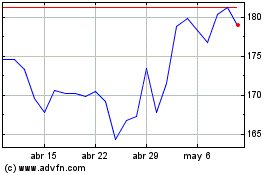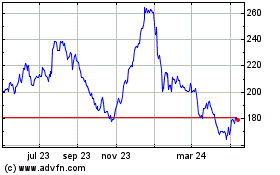By Andy Pasztor
Safety fixes after the first Boeing Co. 737 MAX crash became
snarled in Federal Aviation Administration delays and repetitive
analyses, wasting any chance U.S. regulators had to prevent the
second fatal accident, according to an investigation by the
Transport Department's internal watchdog.
The 52-page report released Wednesday reiterated previously
known lapses by the FAA and Boeing during initial safety approval
of the MAX, but it also raised additional questions about the
seeming lack of urgency both sides displayed during the five months
between the two crashes to develop and implement a safety fix
covering the entire fleet.
Following the first MAX crash in October 2018, it took the FAA
four months just to agree on a timetable for implementing fixes
once they were devised, according to the report by the DOT
inspector general.
The narrative released Wednesday also revealed that FAA
officials also spent months conducting an inconclusive internal
review of problems with the plane's original certification.
Launched in January of 2019, the review got bogged down in
bureaucratic procedures, never got finished and eventually was
abandoned when a second MAX went down that March, according to the
inspector general.
The inspector general's report provides fresh ammunition for FAA
critics in Congress who argue agency officials wasted their chance
to act swiftly and decisively to prevent the second, similar MAX
crash that occurred less than five months later.
An FAA spokesman declined to comment.
The document offers new insights about precisely how long it
took the FAA to chart a course to deal with safety problems after
Lion Air Flight 610 nosedived into the Java Sea in the fall of
2018. The inspector general also lays out, in more detail than
previous reports, the agency's subsequent halting progress coming
to grips with the MAX fleet's hazards in the period that ended with
the fatal crash of Ethiopian Airlines Flight 302 in March 2019.
In most respects, the inspector general's timeline reiterates
previous assessments about lapses by the FAA and Boeing during
initial safety reviews of the MAX. But in spelling out the dates of
specific Boeing and FAA action -- or lack of action -- the report
raises additional questions about the seeming lack of urgency both
sides displayed to develop and implement a safety fix covering the
entire fleet.
A Boeing spokesman said that since the accidents, "we have made
substantial changes within our company to further enhance our
commitment to safety." The company, the spokesman continued, has
pledged "transparency with the FAA during all aspects of the
airplane certification process."
The latest scrutiny adds yet more voices to the extensive chorus
of U.S. lawmakers and global safety experts who have pinpointed
Boeing's failures, extending back to the development of the MAX, to
provide timely and accurate information about an automated
flight-control feature known as MCAS. Misfires of that system led
to both crashes, which took a total of 346 lives and plunged Boeing
into what was then the worst crisis in its 100-plus year history,
until the Covid-19 pandemic.
The report doesn't offer recommendations. In a formal response
to the inspector general's report, Steven Bradbury, the DOT's
general counsel, wrote that it revealed "some strengths in FAA's
aircraft certification process, as well as areas for
improvement."
Safety vetting of the MAX before its 2017 introduction into
service, according to Mr. Bradbury's memo, which was attached to
the report, "was hampered by a lack of effective communication,
both between Boeing and FAA and within FAA," resulting in the
agency receiving incomplete information about MCAS hazards before
approving the plane for passenger service.
The report indicates the FAA didn't finish its official
assessment of safety hazards posed by the MAX fleet until Dec. 12,
2018, almost two full months after the Lion Air crash. But
according to the inspector general, it wasn't until the second week
in January that the agency for the first time "performed its own
detailed analysis of MCAS."
That January date, several FAA engineers told the inspector
general's staff, also was the "first time that they were presented
with a full picture of how MCAS worked."
Then it took another month, until the middle of February, for
the FAA and Boeing to agree on a schedule for implementing fixes to
MCAS's problematic software.
The FAA's internal review of what went wrong with the initial
certification process was still in draft form when the Ethiopian
jet crashed in March and the 737 MAX fleet was grounded globally.
At that point, according to the inspector general, the agency
shelved the document since it had been "overtaken by events."
The inspector general's timeline conflicts with what
high-ranking Boeing engineers and other company officials told some
airline pilots in late 2018 about the anticipated speed of the
pending fixes. At the end of November 2018, company representatives
told leaders of the pilot union at American Airlines Group Inc.
that "relatively straightforward software changes" to MCAS were
slated to be released in a company bulletin in roughly six weeks,
or about mid-January, according to an audio recording of the
meeting that was reviewed by The Wall Street Journal.
By the time the January target had passed, according to the
inspector general, the FAA and Boeing didn't expect the software
fix to be ready until April of 2019. Now, after more than a year of
additional delays and expanded scrutiny of other flight-computer
and cockpit-alert features, besides MCAS, software and hardware
fixes to the MAX fleet are expected to be approved by this
fall.
Wednesday's report goes beyond earlier findings released in
March of this year by Democrats on the House Transportation
Committee, which pinpointed some squandered opportunities by the
FAA to prevent the second crash. The committee's report said that
in December 2018, agency officials "received a briefing from Boeing
that should have raised additional red flags" about the
thoroughness of the plane maker's initial safety assessments
regarding MCAS hazards.
On Wednesday, Rep. Peter DeFazio of Oregon, the Democratic
chairman of the House transportation panel, issued a press release
saying "the more scrutiny we put on Boeing and the FAA, and the
more we dig into why and how the system failed so horribly," the
better chance "we have of fixing the system to ensure no family has
to endure this nightmare again."
--Alison Sider contributed to this article.
Write to Andy Pasztor at andy.pasztor@wsj.com
(END) Dow Jones Newswires
July 01, 2020 14:15 ET (18:15 GMT)
Copyright (c) 2020 Dow Jones & Company, Inc.
Boeing (NYSE:BA)
Gráfica de Acción Histórica
De Mar 2024 a Abr 2024

Boeing (NYSE:BA)
Gráfica de Acción Histórica
De Abr 2023 a Abr 2024
